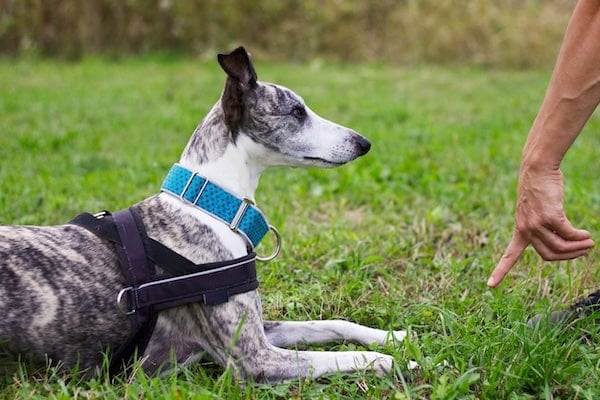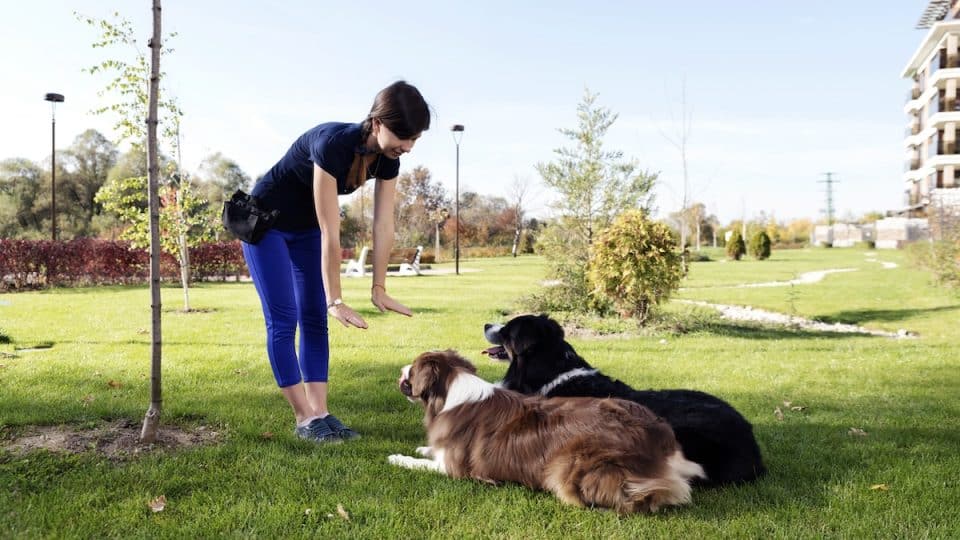- Not a substitute for professional veterinary help.
Boundary training is a valuable skill that teaches dogs where they can and can’t go. Training a dog to stay in a yard prevents them from escaping (both fenced and unfenced yards), protects them from traffic and wildlife, and maintains peace with the neighbors. When used indoors, boundary training can also keep your dog out of certain rooms you may prefer they not be, like the kitchen or bathroom. Seems great, right? But how hard is it to teach?
“Boundary training can be easy for some dogs and tough for others,” explains Annie-Mae Levy, a certified dog trainer at Woofz. But with dedicated practice, most dogs can master boundary training within a few months. The keys to success are consistency, patience, and positive reinforcement.
In this guide, we’ll walk you through how to teach your dog to stay in your yard or out of particular areas in your home. We’ll also share tips for preventing dogs from bolting after distractions.
Rules of Boundary Training
To lay a solid foundation for boundary training, keep the following principles in mind.
- Get everyone on the same page. Make sure everyone in your home understands the training goals. This prevents confusion and reinforces the learning process.
- Be consistent. Mixed signals can confuse your dog’s understanding of the boundary. Some dogs may also test limits if boundaries aren’t enforced consistently.
- Practice frequently. Stick to regular practice sessions—repetition helps reinforce the boundary.
- Supervise closely. Even after your dog has learned their boundary, keep an eye on them. Boundary training is not a perfect substitute for a physical fence, and it doesn’t protect pets from external threats like aggressive dogs or unfamiliar people.
- Be patient. Remember that boundary training is a gradual process. Give your dog time to learn and adapt.
How To Train an Indoor Boundary
Setting boundaries indoors can protect specific areas of your home, like a guest room or a particular couch. It can also keep your dog safe and out of mischief in areas like the kitchen. Plus, if you also want to teach your dog how to stay in the yard, training them indoors first can let your dog practice without all the distractions outside.
To teach your dog how to stay in or out of a certain area inside the home, follow these seven steps.
- Define the boundary. Choose a clear marker for your boundary, such as a doorway or the edge of a stairwell. You could also use masking or painter’s tape to indicate the restricted area visually.
- Guide your dog to the boundary. Use a leash to lead your dog to the edge of the boundary. Stop right before the edge and give a cue, like “stay” or “wait.”
- Cross the boundary. With your dog on their side of the boundary, take one step into the off-limits area.
- Reward your dog for staying put. Your dog may be eager to follow you. If they try to cross, gently guide them back without reward. When they stay behind the boundary, shower them with treats and praise.
- Increase duration. As your dog starts to understand the boundary, gradually extend the time they must stay on their side before receiving a reward.
- Increase distance. Walk further into the restricted area, rewarding your dog for not following you.
- Introduce distractions. Use toys, people, or other distractions to test your dog’s ability to maintain the boundary.
“It may take some repetition, but the dog will eventually learn that staying on their side earns praise and rewards,” Levy explains. For times when you aren’t there to supervise, a physical barrier like a dog gate can help reinforce the boundary.

bernardbodo via iStock
How To Train an Outdoor Boundary, Like a Yard
Teaching your dog to stay within the yard or a set outdoor boundary will follow similar steps as training them inside. However, it’s a lot trickier, since you’ll have less control over the environment and the inevitable distractions, like squirrels, neighbors talking, people walking by, or anything else your dog finds enticing.
To combat this in the beginning, try to train your dog outside during quieter times in the day. For instance, avoid early mornings when people might be walking their dogs or taking their kids to school and wildlife is gearing up for the day.
Here’s how to train your dog to stay in a yard in six steps.
- Define the boundary. Start by marking the boundary area with clear visual cues. Use flags, string, or natural landmarks like trees to create a definitive line your dog can recognize.
- Introduce your dog to the boundary. With your dog on a leash, walk along the boundary line and give the same cue you used indoors, such as “stay” or “wait.”
- Reinforce with rewards. As you walk along the perimeter of their space, reward your dog with treats and praise for staying within it. If your dog crosses over, don’t punish them. Instead, gently guide them back and start again.
- Increase the challenge. Once your dog understands the boundary, challenge them by increasing the distance and duration. First, gradually increase the time they need to hold the boundary before getting a treat. Then, with your dog on a long line, walk further away from the boundary and reward them for staying on their side.
- Introduce distractions. Once your dog reliably respects the boundary, start introducing low-level distractions, like toys, other pets, or people. Reward your dog for staying within their designated area.
- Switch to off-leash time. Once confident, you can practice off-leash. Continue to supervise your dog and lay on the rewards for respecting the boundary.
Aim to practice at least once or twice a day. You’ll know your training is successful when your dog consistently stays within their boundaries, even amid distractions. Remember, this may take some time. Try to maintain realistic expectations and celebrate progress along the way.

Zbynek Pospisil via iStock
Training for Distractions
Your dog may understand their boundaries well enough—until a cat strolls by.
To work on your dog’s impulse control, introduce minor distractions. Levy suggests tossing a toy over the boundary and rewarding your dog for ignoring it. As they improve, gradually introduce more tempting distractions like high-value treats or a helper dog on the other side.
Keep in mind that even the best-trained dogs can have off days. If you foresee a major distraction, like having holiday guests over, consider keeping your dog on a leash or in a separate space until the excitement subsides.
Additionally, while working on boundary training, don’t forget to train a reliable recall. This skill will be invaluable when they spot a squirrel or rabbit and are tempted to bolt.
Risk Management with Boundary Training
Training your dog to stay in the yard or a certain boundary takes time and effort, but slowly reinforcing this behavior through positive reinforcement is preferable to aversive techniques like invisible fences and shock collars.
Aversive methods rely on pain, fear, and discomfort. They can damage your relationship with your dog and cause behavioral problems like fear and aggression. They also create a false sense of security in your dog’s skills, since a reward—like something really good on the other side of the boundary—can make a dog willing to risk a small punishment.
Fortunately, most dogs can learn boundaries—but some may be harder to train than others. According to Levy, this list includes dogs with high prey drives, anxious dogs, and very independent dogs.
Don’t be discouraged, either, if progress seems slow. This process can take months. “Although it may feel slow, steady progress is better than rushing,” Levy adds. If your dog is struggling, she recommends dialing back the distractions while increasing the reward frequency and value. You can also consult a professional trainer to get things on track.
If boundary training isn’t working, consider alternative solutions like hiring a pet sitter or using traditional physical barriers. Exercise pens and tie-outs are also good options. For added peace of mind, a GPS collar can track your dog if they manage to escape. The most important factor is to keep your dog safe!



